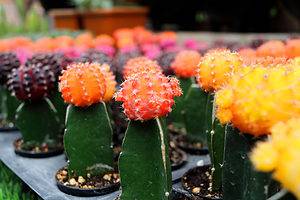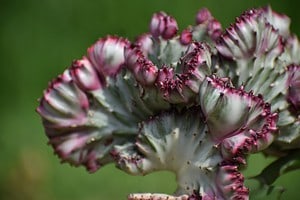Orchid cacti, also known as Epiphyllum cacti, are forest cacti with extraordinarily beautiful flowers on long, flat branches. Orchid cacti are a delight to nurture because of their large, cup-shaped flowers in exquisite hues. This cactus looks great displayed in a hanging basket with the long stalks cascading over the container. Also, they aren’t too challenging to grow at home! These resilient plants can withstand neglect and require little maintenance. They are also a lot of fun to propagate.
Although the world of Epiphyllum cacti is intriguing, it can also be a little challenging to understand. We will break down what orchid cacti are in detail and offer advice on how to grow these remarkable cacti at every stage in this article.
What is an Orchid Cactus?
An orchid cactus is any species of cactus in the genus Epiphyllum in the plant family Cactaceae. They are sometimes referred to as climbing cacti. The majority of Epiphyllum cacti are epiphytes. However, some may also be lithophytes, and they are found in tropical or semitropical woods. Whereas lithophytes grow on rocks, epiphytes live on host plants in the wild and receive their nutrients and hydration from precipitation and the atmosphere.
These plants may be identified by their long, flattened stems that are usually at least a few inches broad and are covered in succulents. Depending on the species or cultivar, the leaves of these plants can reach astonishing lengths of two feet to as high as 10 feet. Because of their typical arching, weeping growth behavior, the stems are excellent candidates for growing in hanging baskets.
Anatomy of the Orchid Cactus
Orchid cacti feature broad, flat stems that are approximately an inch wide and about five millimeters thick. They typically have lobed edges. The blooms are enormous at three to six inches in diameter. They have many petals that range in color from white to crimson. Only at night do the blossoms bloom and they fade by daylight. Orchid cacti produce edible fruit that resembles pitaya fruit quite a bit, though they are not quite as big.
Orchid cacti have smooth, usually flat stems without leaves, while some have three-sided development. These stems can form aerial roots and have notched borders. Yet, the main draw for devotees of these spineless cacti is their blooms. The majority of flowers range in size from four to eight inches. However, some varieties of orchid cacti have blooms that are an incredible 14 inches wide.
While some of these jungle cacti only bloom at night and are pollinated by bats or moths, others bloom during the day and draw pollinators that are active during the day. Areolas, or the notches in the stems of orchid cacti, are where their flowers are created. These blooms usually last just a brief time. They produce edible pitaya-like fruits when pollinated; these fruits are usually referred to as pods.
Areolas also develop secondary stems, which may seem like leaves but are actually just stems. When new stems initially emerge, they are usually spherical and bristly. As they grow, they become flat and lose their bristles.
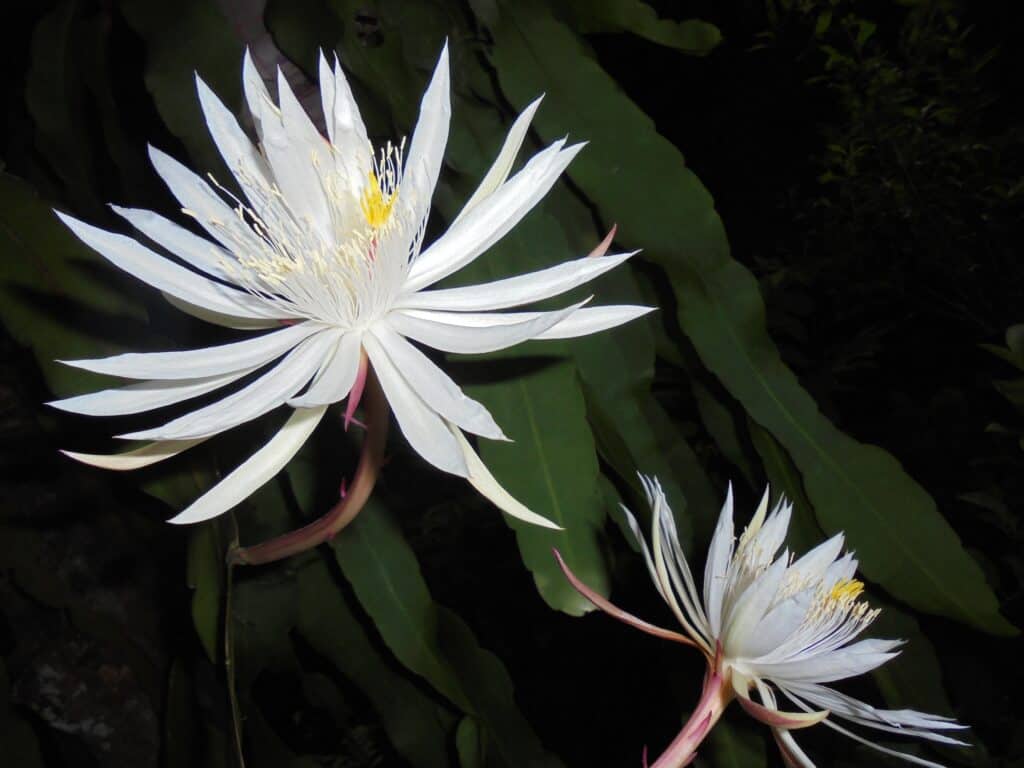
species boast flowers (pictured) that come in a wide range of colors.
©iStock.com/Aloysius Gonzaga Sutrisno
Orchid Cacti Native Environment
Orchid cacti are native to South America and Central America. The fact that members of this species have naturalized in regions like Florida, the Caribbean, and portions of Asia speaks to how easily they grow.
Orchid cacti naturally thrive in warm, humid environments with dappled light in tropical or semi-tropical woodlands. Orchid cacti are related to other houseplants including rat tail and prickly pear cacti as well as the far more well-known holiday plant, the Christmas cactus.
In the 1800s, the first hybrid orchid cacti were developed by selective breeding. Nowadays, hybrid cultivars come in tens of thousands of varieties with almost unlimited bloom variants. And while orchid cacti make wonderful indoor plants, with the correct soil and water, they can also thrive year-round outdoors in USDA hardiness zones 10 to 11.
Orchid Cacti Varieties and Subspecies
Epiphyllum oxypetalum, or the queen of the night cactus, is one of the most well-known orchid cacti that are prevalent in the plant trade. It produces big, fragrant blooms that are often only open for one night.
Epiphyllum baueri is another species that is native to Colombia and Panama. It boasts white flowers that resemble daisies. Epiphyllum chrysocardium, or the fern leaf cactus, is a Mexican species that is beloved for its unusual cream-colored flowers. The climbing cactus or Epiphyllum phyllanthus can be found in Venezuela, Argentina, and Mexico.
Colors of the Orchid Cactus
The stems and overall bodies of orchid cacti are usually any varying shade of green. Some plants may exhibit a faint mauve or brownish hue. The flowers of this cactus can come in many different colors depending on its species. Some orchid cacti flower colors include red, pink, white, cream, orange, yellow, and even purple.
What Will Make My Orchid Cactus Bloom?
In the spring or summer, orchid cacti can display vivid, sizable, fragrant, and night-blooming flowers with proper care. There are a few different things you can do to get your specimen to grow flowers.
To start, give your orchid cactus a good winter break. For the plant to set buds in the winter, it has to have a cold, dry rest period of roughly eight to 10 weeks. During this period, water it very lightly and cease fertilizing.
Ensure that your cactus receives adequate light. All year long, keep your orchid cactus in direct light. Keep the plant away from direct sunlight if you transfer it outside for the summer. Outside of wintertime, fertilizer with a high phosphorus content can also be used to promote more flowers. Feeding should begin in the early spring and continue into the fall.
When it comes down to it, leaving your orchid cactus alone is the greatest thing you can do to encourage it to blossom. Keep the plant in the same spot after the buds start to develop. It will lose its buds and blooms if you move it because of variations in temperature and light. Keep it away from drafty locations as well, such as entrances and air conditioning units.
How to Grow an Orchid Cactus
It is preferable to keep growing orchid cacti indoors unless you can provide them with very specific outdoor temperatures, dappled sunshine, humidity, and permeable potting soil. They want comparable environmental factors as bromeliads and true orchids. When grown outside, they need to have enough ventilation and protection from severe winds.
These plants are easy to grow from seed. It can be difficult to find orchid cacti seeds at local nurseries and there is no assurance that they will grow properly. If you want to grow your own plant from seeds, you’ll need two plants that are both male and female and are concurrently in bloom so you can manually pollinate the blossoms. Due to these challenges as well as the fact that it may take the plants at least four years to start really growing, cutting-based propagation is the simpler and more common method of growing these plants.
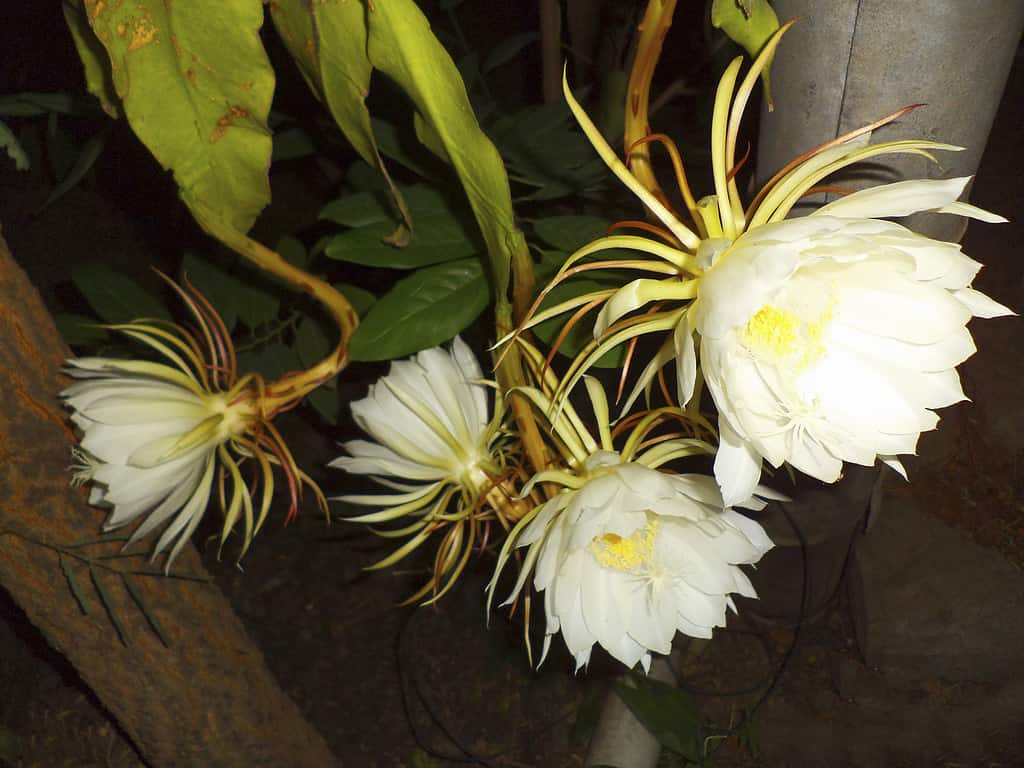
Orchid cacti (pictured) need plenty of sunlight and a smaller pot to encourage flower growth.
©iStock.com/ePhotocorp
Propagating Orchid Cacti
The quickest and simplest technique to grow fresh orchid cacti is through stem cuttings. They may even bloom the following year if you’re lucky.
To start, choose healthy stem portions that are around eight to nine inches long. It might take longer for your cutting to blossom if it isn’t long enough. Let the wound heal completely and develop a callus. This process, which should last at least a week, is crucial to avoid plant rot.
Insert the cutting vertically into a cactus potting mixture that drains quickly and contains extra pumice or perlite. Insert at least two inches of the stem’s bottom into the soil. Keep it in a spot with warm, dappled light. Avoid choosing a container that is too big.
Water the cuttings just one time. After roots start to grow, water them again, making sure the potting mix is wet but not saturated. Keep it at a temperature of around 70 degrees F. The cutting should take root within a month.
Repotting and Transplanting an Orchid Cactus
You should avoid choosing a very large container or hanging basket if you want your orchid cactus to blossom. Being a little rootbound will encourage flower growth.
These plants don’t require regular repotting. You probably won’t need to do it more than once every six to eight years. Repotting should be done after flowering to prevent root disruption. As the trailing stems develop, using a sturdy container will aid in maintaining plant stability.
Pruning an Orchid Cactus
The slow-growing orchid cactus has the potential to become huge and heavy with its trailing stems. If you don’t want to support the stems with unattractive canes or twine, shorten the stems by pruning them off with clean shears or a knife. You can take the cuttings and grow new plants from them via propagation. Usually, new branches emerge from the wound. Your plant will need less water if you cut several stems off at once.
Water Needs for Orchid Cacti
The secret to watering an orchid cactus is finding the perfect balance. In contrast to its cacti relatives, orchid cacti require constant hydration during the growing season. Although damp, the potting mix shouldn’t be waterlogged and will need to drain well.
Before watering, you should ideally let the top third of the potting mix dry out. Reduce watering over the winter and relocate the plant to a cooler area. The following season’s blossoms will be healthier and larger thanks to this method. For these delicate plants, using distilled or filtered water is preferable over tap water.
If your soil is overly damp, especially when temperatures are on the cool side, you may see branch dieback or rust spots. If this continues to be an issue, cut off the infected branches, repot the plant in a dry, quick-draining mix, and water it less often.
Sunlight Needs for Orchid Cacti
Filtered sunlight that resembles the lighting conditions found in their native tropical forest habitat is ideal for orchid cacti. Keep them out of the full midday sun to prevent burning or white scabbing. However, a couple of hours of full morning sun should be okay. Growing these cacti in a hanging basket under a tree’s canopy is effective when done outside.
Avoid placing your orchid cactus in a space where lights are left on after sunset for extended periods of time since this might affect flowering the following year. Too much light may result in yellowing and withered growth in your plant. Too little light might cause fragile, leggy growth.
Soil Needs for Orchid Cacti
You shouldn’t grow your orchid cactus in untreated or unenriched soil. Normal garden soil is extremely compact, and the roots of this cacti won’t be able to handle it, which will cause the plant to die. Keep your orchid cactus in a loose, quickly draining potting mix that has additional light, porous components to aid in drainage. It might be advantageous to add perlite, bark, coconut bark, or pumice to your potting soil mixture.
Fertilizer Needs for Orchid Cacti
To promote healthy development and bud stimulation, sparingly fertilize your orchid cactus a couple of times a year. Be cautious not to overfeed them, since they normally thrive in an environment with few nutrients. It is generally recommended to use a balanced, slow-release fertilizer that isn’t overly rich in nitrogen. Early spring treatment might aid in promoting flower growth.
Temperature and Humidity Needs for Orchid Cacti
The ideal way to grow orchid cacti outside is in containers or hanging baskets so you can bring these delicate plants inside when the weather turns chilly. When it is cold outside or when the temperature falls below 32 degrees F, they won’t survive for very long.
Your orchid cactus may require a different location in the winter than it does during the growing season if you keep it indoors. From spring through fall, temperatures up to 90 degrees F are good. In the winter, a colder location with filtered light is preferable. The ideal range in the winter is between 50 and 58 degrees F, away from radiators and chilly drafts. Relocate your plant to a warmer area once the flowers’ buds start to develop.
To grow, orchid cacti require more humidity than the average cactus species. It may be beneficial to stand the plant on a tray of water in pebbles or use a humidifier.
Pests and Diseases to Watch Out For
Orchid cacti are seldom bothered by harmful insects or illnesses. However, watch out for bothersome fungus gnats, spider mites, aphids, and mealybugs. These plants’ thick stems are a favorite of slugs and snails as well, although hanging them in raised baskets outside helps lessen this issue.
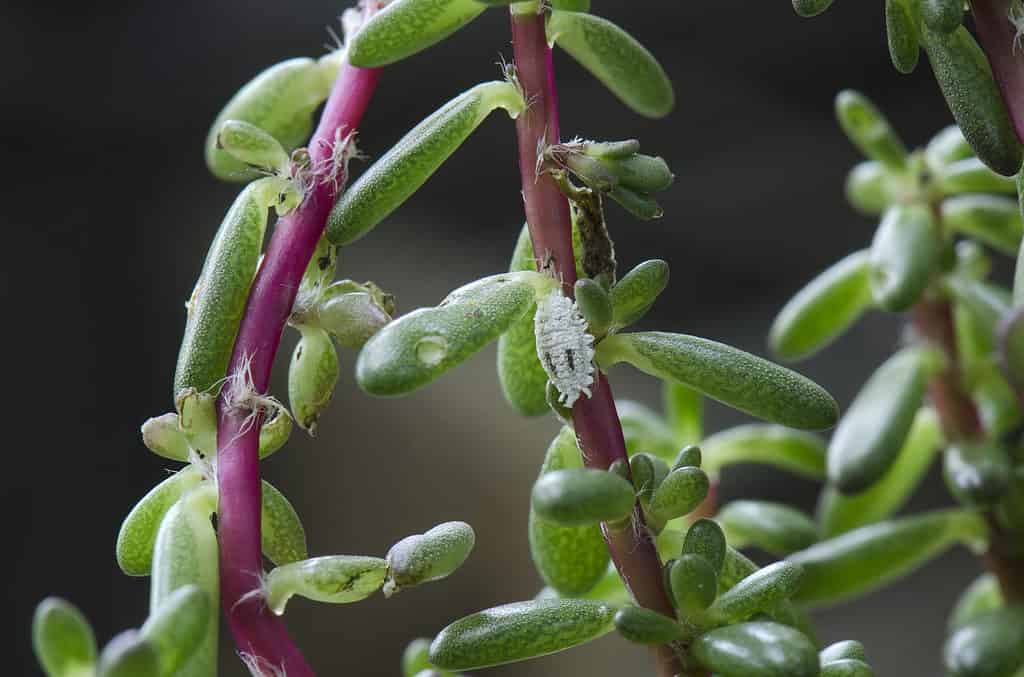
Most succulents and cacti can be harmed by mealybugs (pictured) and should be regularly inspected for signs of infestations.
©panattar/Shutterstock.com
Is It Hard to Grow an Orchid Cactus?
No! If you have an established plant or are able to propagate orchid cacti via cuttings, these plants are very easy to care for.
Orchid cacti are some seriously spectacular desert plants. They are very visually different from other cactus species, and there is simply no match for their brilliant flowers! With the correct growing circumstances, orchid cacti can be enjoyed for many years, as they have a lengthy lifespan. Just be cautious when it comes to temperature, sunshine, and watering schedules.
The photo featured at the top of this post is © iStock.com/samuel howell
Thank you for reading! Have some feedback for us? Contact the AZ Animals editorial team.



